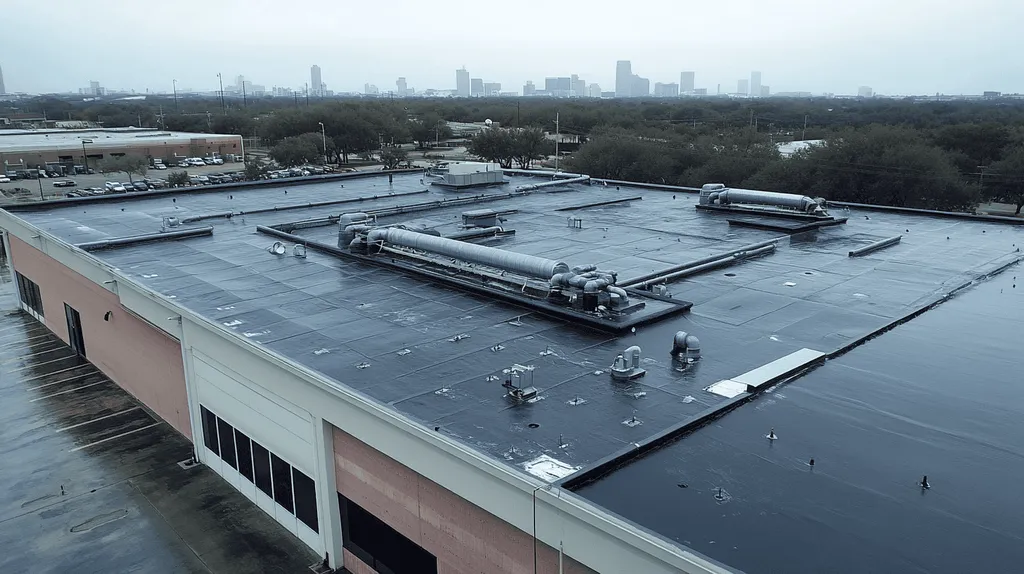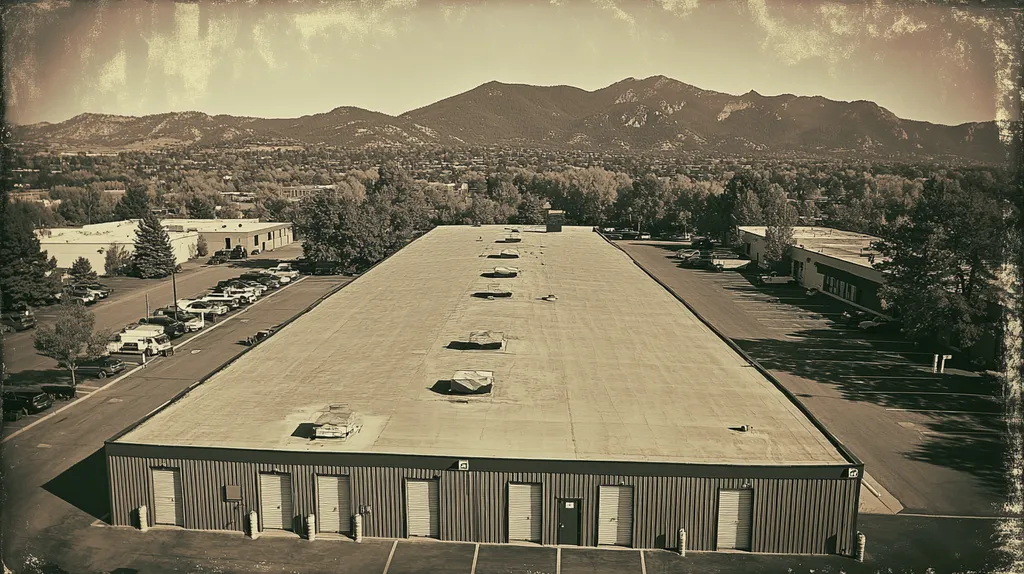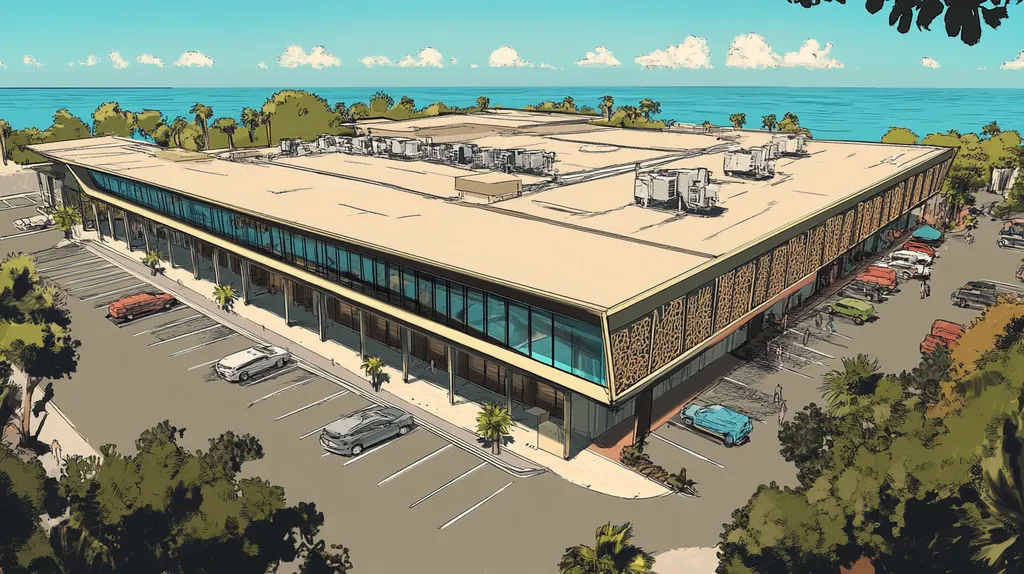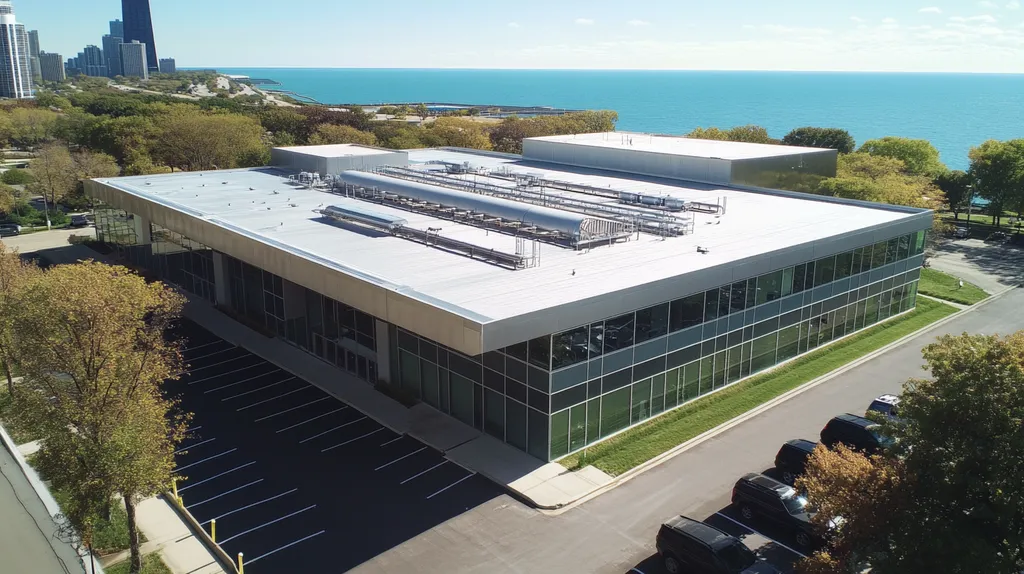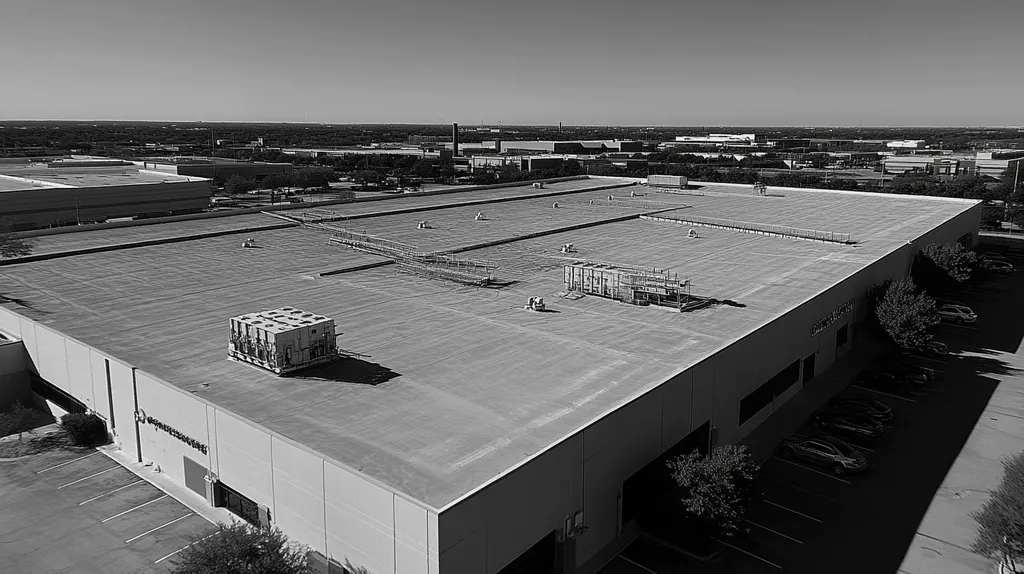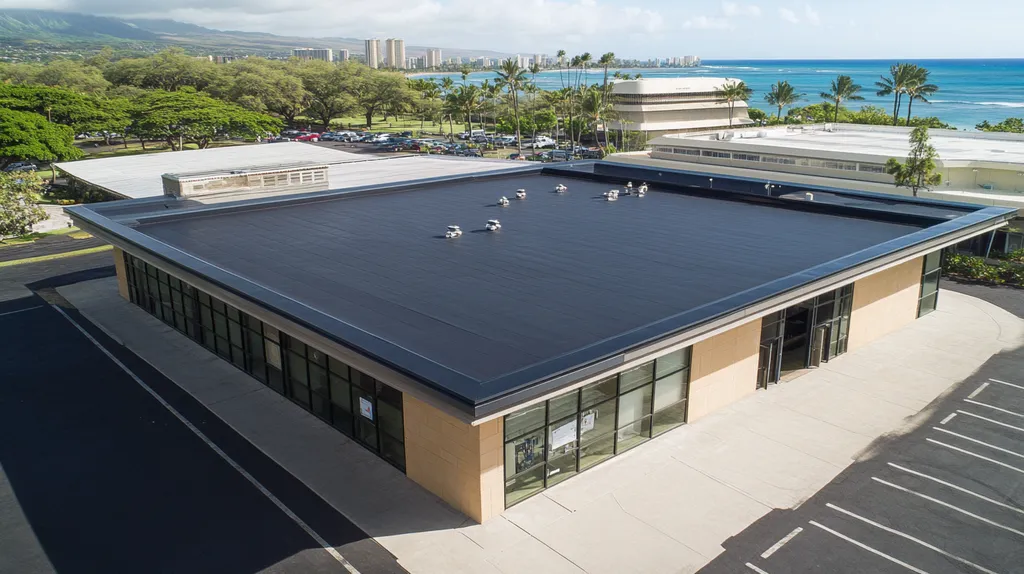Every year, commercial property owners lose millions to premature roof coating failures, with studies showing that improper inspections lead to 40% shorter coating lifespans.
As buildings age and weather patterns become more extreme, the stakes for maintaining roof coatings have never been higher.
This comprehensive guide outlines proven inspection protocols that protect your investment, from evaluating surface conditions to documenting compliance requirements.
Through a methodical examination of performance factors, financial considerations, and risk management strategies, property professionals will learn to implement inspection practices that extend coating life and prevent costly failures.
SECTION 1: PERFORMANCE FACTORS
The performance of a commercial roof coating is key to ensuring its durability and effectiveness. Without regular inspections, property owners can face high repair bills and unnecessary downtime. Notably, the National Roofing Contractors Association highlights that improper maintenance directly leads to leaks, which are responsible for 80% of roofing failures. Understanding these performance factors is vital for property owners and facility managers aiming to protect their investments.
Roof Surface Condition Assessment
Evaluating the condition of the roof surface is a critical starting point for maintaining a commercial roof coating. Routine inspections can pinpoint damage, such as cracks and blisters, that might otherwise go unnoticed. For instance, small blisters can expand into severe problems if left unaddressed.
A thorough visual inspection should focus on identifying signs of wear, like discoloration or chalking of the coating surface. These signs often indicate that the roof coating is losing its protective abilities. Tackling these issues early not only prolongs the roof’s life but also forestalls more severe damage.
Additionally, checking for proper adhesion of the roof coating is essential. Insufficient adhesion can result in delamination, where the coating peels away from the roof material, significantly lessening its effectiveness and allowing moisture to infiltrate, which can lead to structural damage.
Lastly, regular inspections must include clearing all debris, such as leaves and dirt. Accumulated debris can trap moisture, creating a breeding ground for mold and accelerating deterioration of the roofing materials.
Key Action Items
Drainage and Water Management
Proper drainage and water management are crucial for the effectiveness of any commercial roof coating. Insufficient drainage can lead to pooling water, which accelerates wear and increases the risk of system failures. Roofs should be designed to ensure proper pitch and have effective drainage systems to avoid standing water.
Regularly inspecting gutters, downspouts, and scuppers for clogs and damage is essential. Even minor blockages can cause significant pooling, which can compromise the roofing structure. Consistent cleaning and maintenance of these areas are vital to ensuring proper water flow and preventing related issues.
When evaluating drainage systems, it’s important to consider the location of all rooftop fixtures, such as HVAC units and skylights. These elements should not obstruct water flow. Any modifications to the roof layout may necessitate updates to the drainage plan.
Additionally, effective water management practice involves assessing the performance of installed waterproofing measures. Early detection of any failures is critical to avoid more extensive damage.
Key Action Items
Insulation and Ventilation Efficiency
The efficiency of commercial roof coatings directly correlates with the quality of insulation and ventilation systems. Inadequate insulation can lead to thermal bridging, which spikes energy costs and risks damaging roofing materials. This can dramatically affect the long-term performance of the roofing system.
Effective ventilation is equally critical, as it helps control temperature and moisture within the roofing system. Without proper ventilation, heat and moisture can become trapped, fostering mold growth and diminishing the effectiveness of the roof coating. Regular assessments of the ventilation system are crucial for ensuring adequate airflow.
Evaluating insulation and ventilation also means checking for signs of condensation or moisture buildup. Any trapped water can damage insulation, worsening overall performance. Swift action in addressing these concerns is essential to preventing further harm.
Lastly, property managers should think about incorporating energy-efficient features when assessing insulation options. Improved insulation can lower energy usage and boost the sustainability of the roofing system.
Key Action Items
SECTION 2: FINANCIAL CONSIDERATIONS
Grasping the financial implications of a commercial roof coating is vital for property owners and facility managers. Ignoring these important considerations can result in unforeseen expenses and operational interruptions. Studies show that inadequate maintenance can inflate repair costs by up to 30%. This section delves into the costs associated with maintenance, warranty particulars, and strategic budgeting for roof coating longevity.
Cost of Maintenance and Repairs
Routine maintenance for roof coatings isn’t optional—it’s essential for financial prudence. Consistent inspections can reveal minor issues before they morph into significant problems, potentially saving property owners thousands in repairs. For instance, a seemingly insignificant crack can lead to extensive water damage and structural deterioration if neglected.
Common maintenance tasks include thorough inspections, cleaning, and minor reparations. An annual inspection might cost a few hundred dollars, while ignoring repairs could result in bills exceeding tens of thousands. By investing in a dedicated maintenance program, property owners can significantly reduce unexpected costs over time.
Failing to upkeep a roof coating can also nullify warranties, erasing the financial safety net that many depend on. Therefore, it’s imperative for properties to allocate budgets for ongoing maintenance to safeguard their investments.
Key Action Items
Warranty and Lifecycle Costs
Understanding warranty specifics is crucial for any property owner interested in roof coatings. Many manufacturers provide warranties that cover both materials and labor, which typically last from 5 to 20 years. However, these warranties often come with maintenance conditions that must be adhered to in order to remain valid.
If maintenance is overlooked, warranties may become void, exposing property owners to repair expenses that could have been avoided. This financial risk underscores the importance of following manufacturer guidelines and maintaining meticulous documentation of inspections and upkeep.
Additionally, having insight into the lifespan of various coating materials can aid in forecasting long-term costs. For instance, while high-quality coatings may have a higher initial cost, they often deliver superior durability and longevity.
Key Action Items
Budgeting for Coating Replacement
Preparing for the eventual replacement of roof coatings is essential for astute financial planning. Roof coating systems generally have a lifespan of 10 to 15 years, depending on material and environmental factors. Precise budgeting ensures that adequate funds are in place when it’s time to replace the roof.
Setting aside reserves for future coating replacements is a proactive measure to lessen financial pressure. Property managers may also consider incremental funding strategies, such as allocating a certain percentage of the annual maintenance budget specifically for coating replacement.
Moreover, gaining insight into potential replacement costs, including labor and materials, can enhance budgeting practices. Researching current market trends in coating systems will contribute valuable information towards crafting realistic financial projections.
Key Action Items
SECTION 3: COMPLIANCE REQUIREMENTS
Compliance with regulations is not just a bureaucratic necessity; it’s vital for the longevity and performance of commercial roof coatings. Property owners and facility managers who neglect these requirements expose themselves to potential legal issues and financial pitfalls. The stakes are high; penalties for non-compliance can be steep, and the risk of roof failures can disrupt everyday operations. This section covers the critical aspects of adhering to building codes, understanding regulatory standards for roof coatings, and ensuring warranty compliance with proper documentation.
Adherence to Building Codes
Building codes are essential guidelines that govern the installation and upkeep of roof coatings. These codes ensure that roofing systems are not only safe but also energy-efficient and durable. Awareness of both local and national building codes is crucial, as they can differ widely from one area to another.
For example, certain locales may mandate that reflective roof coatings meet specific energy efficiency requirements. Ignoring these codes can lead to fines or the costly necessity of removing and replacing non-compliant roofing systems.
Regular inspections should always include verification of compliance with building codes to avert potential legal troubles. Engaging a certified roofing professional can foster a clear understanding of these regulations and aid in their application.
Key Action Items
Regulatory Standards for Roof Coatings
The landscape of roof coatings is framed by various regulatory standards focused on safety and environmental impact. Agencies such as the Environmental Protection Agency (EPA) and the Occupational Safety and Health Administration (OSHA) set forth essential regulations that roofing materials must obey.
For instance, certain roof coatings are regulated due to their volatile organic compounds (VOCs), necessitating compliance with specific environmental benchmarks. Property managers must ensure that the coatings they choose meet these regulations to avoid fines and other penalties.
Additionally, certifications like Energy Star can facilitate material selection, reassuring managers that the products used uphold stringent performance standards and contribute positively to energy conservation. By routinely reviewing these regulatory standards, property owners can make informed choices that bolster the roof’s efficiency and compliance.
Key Action Items
Warranty Compliance and Documentation
Warranty compliance represents a cornerstone in the longevity of commercial roof coatings. Most manufacturers stipulate specific conditions that must be met to keep warranties in effect.
Keeping meticulous records is critical for warranty compliance. Facility managers should maintain thorough documentation of all inspections, maintenance tasks, and repairs on the roofing system. This serves as proof of compliance when it’s time to make warranty claims.
Furthermore, adhering to maintenance schedules as dictated by warranties can prevent the premature breakdown of the roof coating. Moreover, ongoing assessments can help identify and address issues before they escalate into significant problems.
In summary, maintaining organized documentation and routinely satisfying warranty requirements not only protects investments but also fortifies the property manager’s position when dealing with manufacturers about claims.
Key Action Items
SECTION 4: RISK MANAGEMENT
Commercial roof coatings serve as a critical defense for properties, yet neglecting risk management can have severe consequences, including costly leaks and structural failures. Estimates suggest that a single roof leak can result in damages of up to $100,000 for every 1,000 square feet affected. To protect investments, proactive measures must focus on identifying leak sources, assessing structural integrity, and mitigating weather-related damage. This section delves into these essential components.
Identifying Potential Leak Sources
Identifying potential leak sources is a fundamental element of effective risk management. Common leak culprits include seam failures, structural penetrations, and drainage issues. Regular inspections should emphasize checking for blisters, cracks, and loose seams, as these could indicate impending water intrusion.
Property managers need to scrutinize the condition of flashings around critical areas like HVAC units, skylights, and roof vents, which are frequent targets for moisture entry. Timely action to resolve these issues can avert extensive damage and expensive repairs.
Implementing a routine inspection schedule is a proactive strategy. Engaging qualified roofing professionals ensures that all potential leak sources are systematically identified and addressed. Additionally, innovative technologies such as infrared imaging can enhance inspections, allowing for early detection of moisture trapped beneath the surface.
Key Action Items
Assessing Structural Integrity
Assessing the structural integrity of a commercial roof is essential for effective risk management. A declining roof structure can undermine the coating’s performance and lead to potential failures. Property owners must routinely look for signs such as sagging, pooling water, or visible damage to the underlying materials.
Considering a structural engineer’s assessment can yield critical insights. Their expertise may uncover vulnerabilities and recommend necessary reinforcements before issues escalate.
Regular maintenance activities, including clearing debris and ensuring proper drainage, aid in maintaining structural integrity. Blocked drains can lead to water accumulation, adding undue stress to the roof over time. A proactive approach to maintenance allows for real-time monitoring and timely interventions.
Key Action Items
Mitigating Weather-Related Damage
Weather events significantly threaten commercial roof coatings. High winds, heavy rain, and extreme temperatures can lead to accelerated wear, raising the likelihood of leaks. Property managers need to be prepared to shield their roofs against harsh elements.
Preventative strategies like wind-resistant coatings and well-designed drainage systems can substantially reduce weather-related risks. For example, ensuring gutters and downspouts are free of debris promotes efficient water drainage from the roof.
Following storms, regular inspections are crucial for assessing any damage incurred during inclement weather. Quick identification of issues allows for timely repairs, preventing minor problems from developing into costly repairs. Staying aware of local weather patterns provides valuable context for future risk assessment.
Key Action Items
SECTION 5: OPERATIONAL PROCEDURES
Effective roof inspections form the backbone of sustaining the longevity and efficiency of commercial roof coatings. With approximately 14% of commercial roofs failing in the first 20 years, thorough operational procedures are more critical than ever. This section emphasizes the necessity of diligent pre-inspection preparations, systematic inspection techniques, and accurate documentation practices, each serving as a safeguard for property investments.
Pre-Inspection Preparation and Safety
Preparation is vital before initiating any roof inspection. Inspectors should thoroughly review architectural blueprints and previous inspection reports to identify potential trouble spots. Implementing effective safety protocols, such as using harnesses and safety goggles, greatly mitigates the risk of accidents during inspections.
Clear communication is equally essential. Property managers should notify staff of the upcoming inspections, ensuring no one inadvertently works on the roof during this period. Having a specialized team solely dedicated to inspections can significantly streamline the procedure and enhance efficiency.
Lastly, weather conditions must be factored into the planning. Ideal inspection days are dry with minimal winds, as this enhances visibility and safety, allowing for a more accurate assessment of roof coatings. Conducting inspections during wet conditions can lead to oversight of existing issues.
Key Action Items
Conducting Thorough Roof Inspections
A systematic approach during the inspection is crucial for capturing all relevant data. Inspectors should start with a comprehensive check of the roof surface, looking for cracks, blisters, and peeling, as early detection can significantly reduce future repair costs.
Special attention should focus on seams and flashings, common infiltration points for moisture. Additionally, inspecting rooftop equipment, like HVAC units, is imperative to ensure they do not obstruct drainage or exacerbate wear on the coating.
Beyond visual checks, employing advanced tools such as infrared thermography can uncover hidden moisture issues. This technology aids in identifying areas with insufficient insulation or compromised seals, paving the way for proactive preventative measures.
Key Action Items
Documenting and Tracking Findings
Careful documentation is essential to a successful inspection process. Each finding should be recorded comprehensively, including photographs and specific descriptions of observed issues. This record forms an invaluable historical log that can guide both current and future maintenance strategies.
Implementing a tracking system for inspections is critical. By routinely conducting inspections, patterns regarding the roof coating’s performance over time can be identified. This insight assists in budgeting and forecasting future maintenance needs.
Moreover, sharing inspection documentation with stakeholders fosters transparency and facilitates discussions on needed repairs and potential upgrades, reinforcing the commitment to roof sustainability.
Key Action Items
SECTION 5: OPERATIONAL PROCEDURES
Effective roof inspections are vital for preserving the longevity and performance of commercial roof coatings. With around 14% of commercial roofs failing within the first 20 years, neglecting rigorous inspection procedures can lead to significant financial strain. Establishing systematic operations for pre-inspection safety, thorough evaluations, and careful documentation helps property managers protect their investments and maximize the lifespan of their roofs.
Pre-Inspection Preparation and Safety
Preparation is a critical precursor to any roof inspection. Inspectors should thoroughly review blueprints and previous inspection reports to pinpoint potential trouble spots. Establishing robust safety protocols, including harness and goggles usage, minimizes the risk of accidents on the roof.
Communication is a key element as well. Property managers must inform the staff of the inspection schedule to ensure that no one is inadvertently working on the roof ground during this crucial evaluation. Creating a specialized team dedicated to inspections can enhance both efficiency and clarity during the process.
Weather conditions are another important consideration. Optimal inspection days are dry and calm, improving visibility and reducing safety risks. Conducting assessments during wet conditions can hinder the ability to identify existing issues accurately.
Key Action Items
Conducting Thorough Roof Inspections
A systematic approach during the inspection process is essential to capture all relevant data effectively. Inspectors should start with a comprehensive examination of the roof surface, checking for cracks, blisters, and peeling. Identifying these issues early can prevent costly repairs down the line.
Particular attention should be directed to seams and flashings, which are typical entry points for moisture. Inspectors need to assess rooftop equipment, such as HVAC units, ensuring they do not obstruct drainage or give rise to further wear on the coating.
Beyond visual checks, employing advanced tools like infrared thermography can help reveal hidden moisture issues. This technology assists in identifying areas with inadequate insulation or compromised seals, leading to proactive and timely remediation strategies.
Key Action Items
Documenting and Tracking Findings
Meticulous documentation is a cornerstone of a successful inspection process. Each finding should be recorded in detail, including photographs and descriptions of observed issues. This historical log provides a vital reference for both current and future maintenance strategies.
Property managers should establish a tracking system for inspections. Regular inspections reveal patterns, offering insights into the roof coating’s performance. This data facilitates accurate forecasting of future maintenance and budgeting needs.
Moreover, sharing documentation with relevant stakeholders enhances transparency. Keeping all parties informed encourages discussions about repairs or necessary upgrades, bolstering the commitment to roof sustainability.
Key Action Items
Looking Ahead
With 40% of commercial roofs failing prematurely due to inadequate inspections, the stakes for proper coating maintenance have never been higher.
The evolution from traditional built-up roofs to today’s advanced coating systems demands a more sophisticated approach to inspection and maintenance protocols.
Property owners who implement systematic inspection procedures, maintain proper documentation, and stay ahead of compliance requirements position themselves to extend their roof coating’s lifespan by up to 25 years.
As weather patterns become more extreme and building codes grow stricter, the difference between success and failure increasingly hinges on following established inspection best practices.
Those who adapt their inspection protocols to meet these emerging challenges will protect their investments while avoiding costly failures that plague unprepared properties.
FREQUENTLY ASKED QUESTIONS
Q. How do I assess the condition of my commercial roof?
A. Start with a visual inspection focusing on signs of wear like discoloration or blisters. Ensure proper adhesion of the roof coating and clear any debris to prevent moisture retention. Regular assessments can help with early detection of problems and ensure a longer lifespan.
Q. What are the costs associated with maintaining a commercial roof?
A. Routine maintenance costs are essential and can prevent significant repairs. Regular inspections may range from a few hundred dollars annually, whereas neglect can lead to repair bills exceeding tens of thousands. Establishing a maintenance program significantly reduces unexpected expenses over time.
Q. How do building codes affect my commercial roof?
A. Building codes ensure roofing systems are safe and efficient. Non-compliance with these codes can lead to fines and the need for costly changes. Regularly verify adherence to local and national codes during inspections to avoid potential legal issues.
Q. What should I do to identify potential leak sources on my commercial roof?
A. Focus on inspecting seams, flashings, and any structural penetrations. Regular checks for blisters, cracks, and drainage issues are also essential. Engaging professional help and utilizing technology like infrared imaging can assist in detecting vulnerabilities before they lead to costly leaks.
Q. How can I ensure compliance with warranty requirements for roof coatings?
A. Maintain detailed records of all inspections and upkeep performed. Adhere to the maintenance schedule specified in your warranty terms to avoid voiding coverage. Regular assessments prevent issues that could affect the roof’s lifespan and warranty validity.
Q. What operational procedures should I follow for effective roof inspections?
A. Preparing for inspections includes reviewing blueprints, establishing safety protocols, and ensuring good communication with staff. A systematic approach during inspections, including checking surfaces and using advanced tools, is vital for identifying issues that could affect your roof’s efficiency.
Q. What new roofing technologies can I consider for commercial roofs?
A. Consider advanced synthetic roof coatings that offer better durability and energy efficiency. Technologies like reflective coatings reduce heat absorption, and digital monitoring systems can provide real-time data on moisture levels. Upgrading to these innovative solutions can enhance your roof’s performance and longevity.

